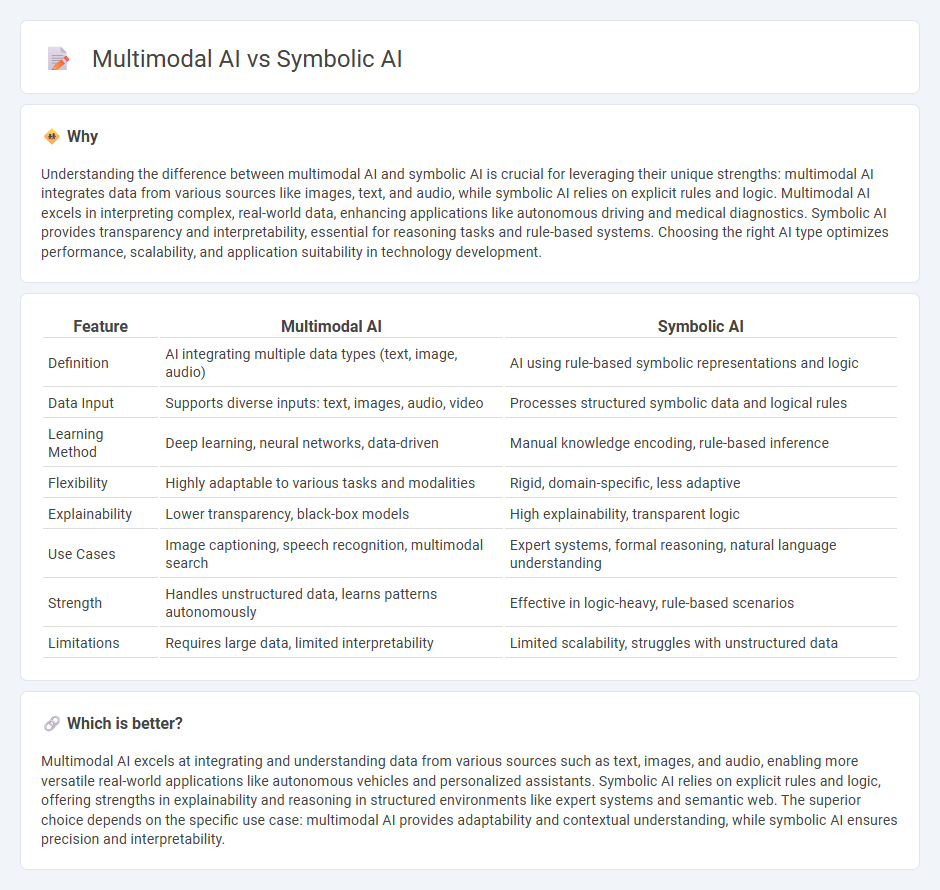
Multimodal AI integrates multiple data types such as text, images, and audio to enhance machine learning models, improving their ability to understand and generate complex information. Symbolic AI, based on explicit rules and logic, excels in reasoning and knowledge representation but struggles with unstructured data. Explore how these approaches differ and complement each other in advancing artificial intelligence.
Why it is important
Understanding the difference between multimodal AI and symbolic AI is crucial for leveraging their unique strengths: multimodal AI integrates data from various sources like images, text, and audio, while symbolic AI relies on explicit rules and logic. Multimodal AI excels in interpreting complex, real-world data, enhancing applications like autonomous driving and medical diagnostics. Symbolic AI provides transparency and interpretability, essential for reasoning tasks and rule-based systems. Choosing the right AI type optimizes performance, scalability, and application suitability in technology development.
Comparison Table
| Feature | Multimodal AI | Symbolic AI |
|---|---|---|
| Definition | AI integrating multiple data types (text, image, audio) | AI using rule-based symbolic representations and logic |
| Data Input | Supports diverse inputs: text, images, audio, video | Processes structured symbolic data and logical rules |
| Learning Method | Deep learning, neural networks, data-driven | Manual knowledge encoding, rule-based inference |
| Flexibility | Highly adaptable to various tasks and modalities | Rigid, domain-specific, less adaptive |
| Explainability | Lower transparency, black-box models | High explainability, transparent logic |
| Use Cases | Image captioning, speech recognition, multimodal search | Expert systems, formal reasoning, natural language understanding |
| Strength | Handles unstructured data, learns patterns autonomously | Effective in logic-heavy, rule-based scenarios |
| Limitations | Requires large data, limited interpretability | Limited scalability, struggles with unstructured data |
Which is better?
Multimodal AI excels at integrating and understanding data from various sources such as text, images, and audio, enabling more versatile real-world applications like autonomous vehicles and personalized assistants. Symbolic AI relies on explicit rules and logic, offering strengths in explainability and reasoning in structured environments like expert systems and semantic web. The superior choice depends on the specific use case: multimodal AI provides adaptability and contextual understanding, while symbolic AI ensures precision and interpretability.
Connection
Multimodal AI integrates diverse data types such as text, images, and audio to enhance understanding, while symbolic AI leverages structured knowledge representations and logic-based reasoning. Their connection lies in combining multimodal data processing with symbolic reasoning to improve interpretability, context-awareness, and decision-making in artificial intelligence systems. This hybrid approach enables more robust AI applications in fields like natural language processing, robotics, and autonomous systems.
Key Terms
Knowledge Representation
Symbolic AI relies on explicit knowledge representation using logic, rules, and structured symbols to model human reasoning, enabling transparent and interpretable decision-making processes. Multimodal AI integrates diverse data types such as text, images, audio, and video, employing neural networks to create distributed representations that capture complex patterns across modalities but often lack explicit symbolic reasoning. Explore the differences in knowledge representation strategies to understand how these AI paradigms address complex problem-solving.
Data Fusion
Symbolic AI relies on structured knowledge representation and logical rules, enabling precise reasoning with explicit data. Multimodal AI integrates diverse data types such as text, images, and audio, utilizing advanced data fusion techniques to create a cohesive understanding across modalities. Explore more about how data fusion enhances AI capabilities by combining symbolic reasoning with multimodal inputs.
Reasoning
Symbolic AI excels in explicit logical reasoning through predefined rules and structured knowledge representations, enabling transparent decision-making processes. Multimodal AI integrates diverse data types like text, images, and audio, enhancing reasoning by correlating multimodal inputs but often relying on implicit patterns within deep learning models. Explore advanced comparative analyses to understand how these approaches shape the future of intelligent systems.
Source and External Links
What is Symbolic AI? - DataCamp - Symbolic AI is a subfield focused on processing and manipulating symbols and concepts using logic-based programming to enable machines to reason and think like humans through rule-based inference and deduction.
Symbolic AI: Revolutionizing Rule-Based Systems - SmythOS - Symbolic AI mimics human reasoning by using human-readable symbols and logical rules to solve complex problems with transparency, providing traceable and interpretable decision-making unlike many modern AI systems.
A Gentle Introduction to Symbolic AI - KDnuggets - Symbolic AI focuses on knowledge representation and reasoning rather than data-driven pattern recognition and is gaining renewed interest through hybrid neuro-symbolic approaches combining symbolic logic with neural networks for enhanced interpretability and adaptability.
 dowidth.com
dowidth.com